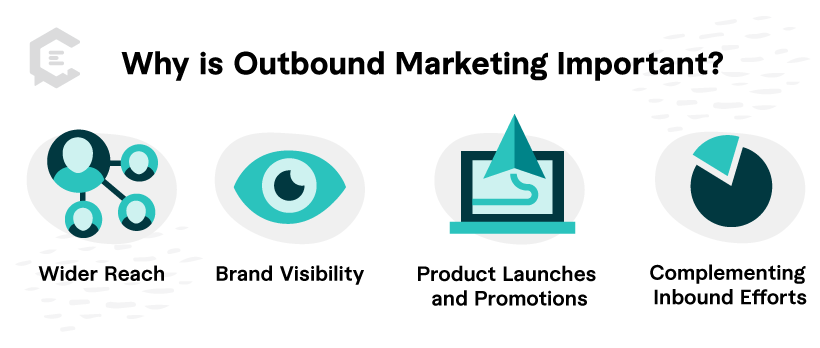What is outbound marketing?
Outbound marketing is a traditional marketing approach where an organization communicates to a large audience who may or may not be seeking that information. It’s a one-way dialogue that assumes if you get content in front of the masses, you’ll find some people who want to receive it.
Outbound marketing has been prominent for many years. But changing consumer behavior, plus ad-blocking software, has diminished its effectiveness. Many modern marketing strategies focus on inbound marketing instead. That’s where brands create high-quality content that addresses the needs and interests of their target audience.
Despite the shift toward more personalized inbound strategies, outbound marketing is still a tool every marketer should have in their toolkit.

Why is outbound marketing important?
While outbound marketing has declined, it still holds value for specific businesses and marketing strategies. Here are some reasons why outbound marketing is still considered necessary in particular contexts:
- Wider reach: Techniques such as TV commercials and large-scale print campaigns have the potential to reach a broader audience quickly.
- Brand visibility: Consistent exposure to a brand’s message through outbound channels reinforces brand recognition leading to higher visibility metrics.
- Complementing inbound efforts: Outbound marketing complements inbound strategies to create a more comprehensive marketing approach. For example, using outbound methods to promote a new piece of valuable content (such as a webinar or white paper) can help attract an initial audience to engage with the content. This wide-net approach is particularly effective for top-of-funnel strategies.
- Product launches and promotions: Outbound marketing can be effective for announcing new product launches, special offers, or time-sensitive promotions.
Where can outbound marketing be effective?
For a long time, outbound marketing was the only solution for marketers who wanted to reach people. The advent of the internet has shifted how companies and people communicate. We’re spending more and more time engaging in our internet communities. But, we still do go outside and interact with people in real life. And that’s where outbound marketing can excel.
Some of the places you’ve likely seen outbound marketing include the following:
- Billboards
- Television commercials
- Posters
- Radio spots
- Press releases
According to a survey of marketers, the most effective tactics (in order) include:
- Email marketing
- Cold calling
- Direct mail
- Search ads
- Social media ads
- Tradeshows
Conversely, the outbound marketing tactics believed to be least effective are print ads and press releases. Not coincidentally, print ads and press releases are nearly impossible to measure.
Audience engagement
Outbound marketing is often referred to as interruption marketing. Meaning, it finds people doing something unrelated and then introduces them to the campaign.
It rarely has to do with the context of the situation. It’s more to do with the ability to reach large quantities of people. The audience isn’t asking for this information now. So, they may or may not resonate with it. But they are receiving the information! Outbound marketing’s intrusive nature paves the way for multiple touchpoints with your brand.
Some things to keep in mind
It’s important to note that while outbound marketing is still valuable in certain situations, businesses should be mindful of the overall marketing landscape and the preferences of their target audience.
Interruptive nature
Outbound marketing is meant to interrupt the audience’s experience. Now, that may sound negative. But all it means is that the audience receives the promotion without actively seeking it out.
If you make the interruption worthwhile, audiences will forgive the intrusion. Do this by making your outbound marketing informative and entertaining, or by offering them something valuable.
Emphasis on volume and reach
The primary goal of outbound marketing is to reach as many people as possible. This approach focuses on the quantity of leads over the quality. That can be solved with an effective marketing funnel that guides the leads through the customer journey, converting passersby into loyal customers.
Limited audience engagement
Outbound marketing offers limited opportunities for audience engagement or two-way communication. The message is delivered, but there’s limited scope for immediate interaction. Address this with a strong follow-up plan or by converting complex outbound strategies into a drip campaign.
Lower ROI
Outbound marketing can feel like throwing spaghetti at a wall to see what sticks. This practice leads to a lot of waste and inevitably lower ROI. However, the right campaign partnered with the increased brand visibility has the potential to strike gold.
Ready to elevate your outbound marketing?
Outbound Marketing may feel old school, but some tried and true methods still work. Incorporating a well-balanced marketing strategy combining outbound and inbound tactics is essential. That’ll likely yield better results in today’s consumer-centric and digitally connected world.
Talk to a content specialist at Clearvoice today for outbound strategies, inbound content, and campaigns that deliver!





